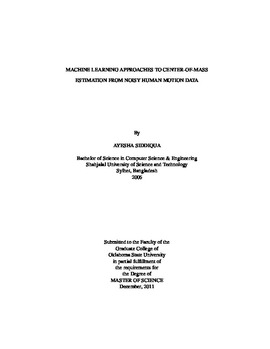| dc.description.abstract | The focus of this research is to estimate Center Of Mass (COM) from noisy motion data. COM is a 3D point in the human body around which the mass of the whole body is equally distributed in each direction, and it plays an important role in many biomechanical studies of human motion, such as gait stability assessment. Traditionally, COM is computed using the Dempster's technique where the total COM is the sum of the weighted segmental COMs. Computation of COM normally requires expensive optical, mechanical and electro-magnetic motion capture systems (MOCAP). Instead of high precision MOCAP systems, we can use low-cost sensors such as inertial motion sensors for efficient motion acquisition to compute COM. However, sensor-based motion acquisition could be noisy due to various ambient interference conditions and may be incomplete due to a limited number of sensors used. As a result, direct computation of COM from noisy motion data could be unreliable and even unusable in practice. In this research we have proposed two machine approaches to address this problem, i.e., manifold mapping and Gaussian Process Regression (GPR). First, we have designed a torus manifold which is a low-dimensional space to represent complex motion kinematics via two variables, i.e., the gait and the pose, representing different walking styles and different stages in a walking cycle, respectively. This torus manifold is shared by motion data (MOCAP) and the corresponding COM trajectories and provides with continuous space to extrapolate unknown motion along its COM trajectory. Moreover, given a noisy motion sequence, the torus manifold can be used to play a filtering role to denoise the motion data as well as a bridge to map the filtered motion data to the corresponding COM sequence. On the other hand, GPR does not account motion kinematics explicitly, and it directly approximates a non-linear mapping function between the input space (motion data) to the output space (COM data) where the covariance structure learned from noiseless motion data plays an important role for COM prediction. Our experiment has shown that GPR works better than the torus manifold for COM estimation from noiseless motion data. However, the performance of GPR degrades as the noise level increases in the motion data, largely due to the fact that its dependence on the covariance structure learned from the noiseless training data does not match that of the noisy motion data. In other words, unlike the torus manifold-based method, there is no filtering effect from GRP which makes it less accurate to estimate COM under noisy motion data. Still, both machine learning techniques have shown significant advantage over the method of direct computation of COM from noisy motion data. | |
